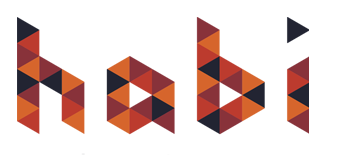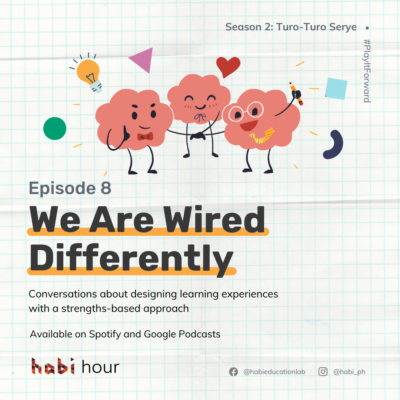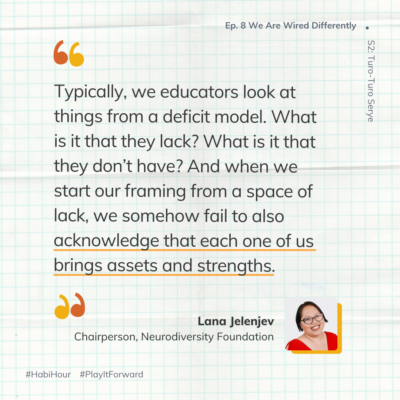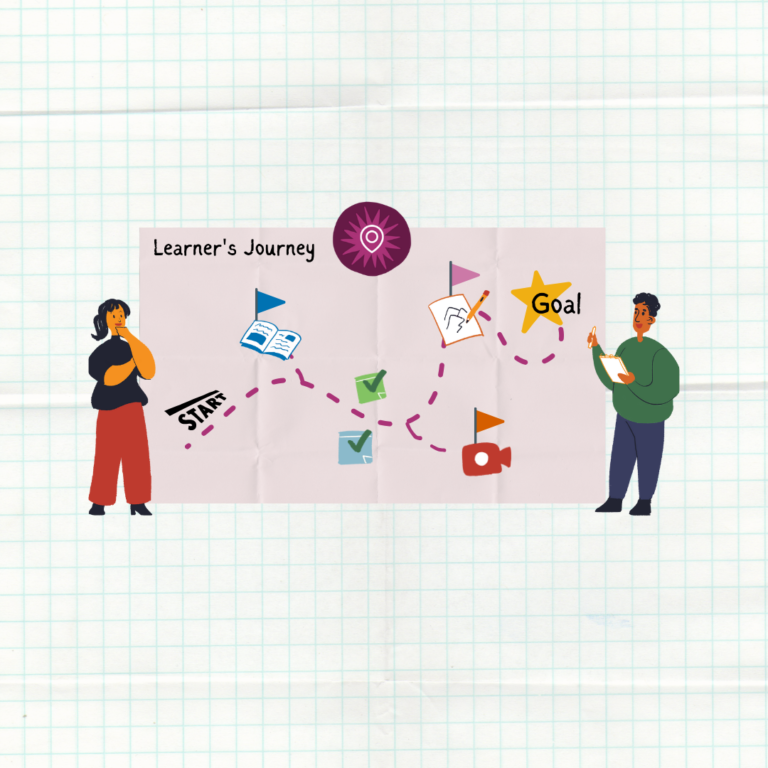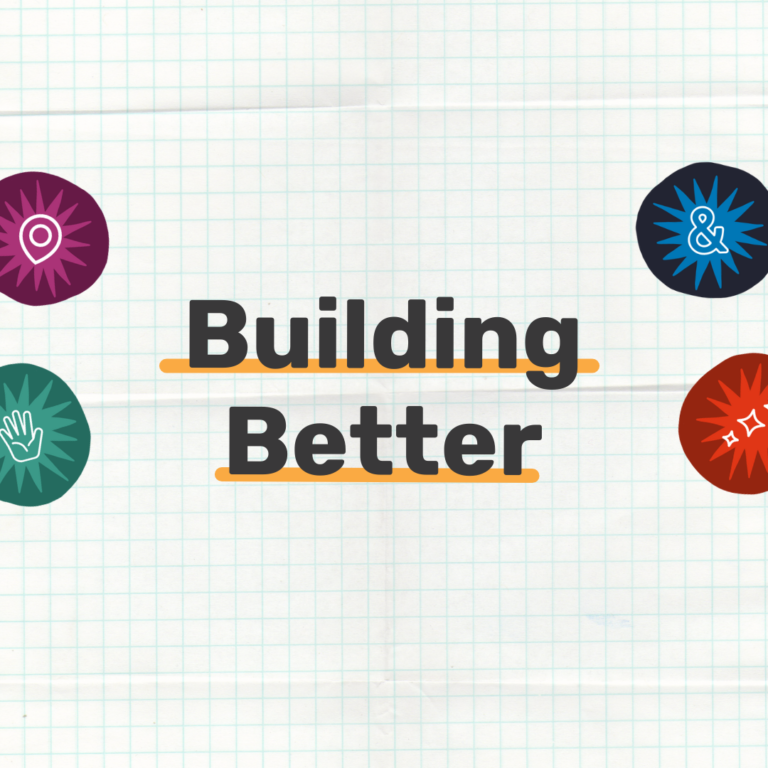Conversations about designing learning experiences with a strengths-based approach
Overview
28 May 2021 | 17 min and 35s
In Habi, we’ve been talking about the MISMO framework a lot as the main tool we use in designing learning experiences. It is grounded in the principles of Universal Design for Learning and strengths-based approaches, but where does neurodiversity come in? In today’s Habi Hour episode, we sit down with Lana Jelenjev, chairperson of the Neurodiversity Foundation, to talk about how we else we might approach “starting contexts” and designing “option and alternatives” for our learners through the lens of neurodiversity.
Transcript
Introductions and Check In
CELINA: Have you heard about the MISMO Framework? This is the learning experience design tool we use in Habi. Each letter in MISMO stands for a step in the design process which we encourage educators and learning experience designers to go through to craft a well-designed learning experience.
M – Mindset: This pertains to your philosophy as a teacher designer. You might ask yourself questions like “What is my role in the learning experience?” or “Are there values and guiding principles we have to be mindful of when designing?” “What am I really good at as a teacher-designer?”
I – Intended Outcomes: What knowledge, skills, and attitudes will they learn? What will they discover about themselves?
S – Starting Context: What do the learners regularly do? What is their day like? Are there barriers to their learning? What motivates them and brings them delight where will they be when they participate in the learning experience?
M – Modular Steps: What will the learning experience be like? What tools and platforms will the learners access? and finally…
O – Options and Alternatives: Does the experience present barriers for differently-abled learners? How can we provide space for learners to choose and customize their learning?
M-I-S-M-O. The MISMO Framework is our way of simplifying UDL or Universal Design for Learning and to promote inclusive practice and learning spaces. And in today’s episode we will look at more possibilities of fleshing out “S” (starting contexts) and designing “O” (options and alternatives) for our learners through the lens of neurodiversity.
[Habi Hour Intro]
CELINA: Today we’re talking to Lana Jelenjev, a community alchemist, author, and learning experience designer.
Kuwentuhan
LANA: I have been here in the Netherlands for the past 15 years now. I’m a proud graduate of the University of the Philippines and have been in the field of education for quite some time now. So when I was in the Philippines I used to teach from preschool to university level, help set up some schools, and train teachers. When I came here in the Netherlands I helped organizations, primarily founders and decision makers, in creating impactful online learning programs and online learning communities.
CELINA: Lana is also the Chairperson for the Neurodiversity Foundation in the Netherlands
LANA: One of the reasons also why it became apparent for me to explore this this deeper is because I have a son who’s gifted. But at a very young age I already noticed that he thinks and acts differently but that’s also one of the reasons why I did further schooling around gifted and talented education and that’s how I got introduced to this idea of neurodiversity.
So I’m the Chairperson for Neurodiversity Foundation which started about three years ago here in the Netherlands, together with our Director, Tjerk Feitsma. And then at that time that time when Tjerk approached me about setting up the foundation it was a quick “Yes” for me maybe because I realized that the field of neurodiversity is very much unexplored not just in the diversity and inclusion field but more importantly within the educational setting.
CELINA: Neurodiversity. Big word? Let’s first look into what neurodiversity means.
LANA: Most of the time the conversations around children would say ADHD, Dyslexia, or Autism has always been around deficit or disorder and at dysfunction. Neurodiversity urges us to discuss brain diversity; meaning each one of us have different brains, we’re all differently wired. If we look at it from that lens and tying it with say for example biodiversity and cultural diversity. So no culture is the same, no plant is the same. It’s the same with us humans, no humans are the same. Our brains are also different. It’s a paradigm shift on how we think about our strengths and the diversity that our strengths bring in.
CELINA: The term neurodiversity was coined in 1998 to grow awareness of how our brains are wired differently and instead of seeing a person with ADHD, Autism or Dyslexia as having deficits, we approach neurodivergent learners as having unique strengths and unique ways of thinking and learning which we, as learning experience designers, strive to support. But how deep are we into understanding how it applies in teaching and learning settings?
LANA: I would say we’re barely at the tip of the iceberg or just scratching the surface here or nowhere near where we want to be when it comes to educating teachers around the importance of neurodiversity. Being a passionate educator, I see this as crucial to the work that we do. I remember the time when multiple intelligences came in the picture and it was revolutionary for education. The idea that we have different intelligences was revolutionary and yet you know globally, and I’m not just saying within the setting of the Philippines, it did not cause that much of an impact in how we shifted the lesson planning in providing of activities. It gave us awareness, yes.
CELINA: As I listened to Lana speak, I couldn’t help but think of my own practices when I dissect the S/Starting Context of my learners. Sometimes, we teachers are so busy with filling the gaps and fixing what’s not going right, that we tend to overlook what IS going right, and what our learners are already good at.
LANA: We look at things from a deficit model. What is it that they lacked? What is it that they don’t have? And when we when we start our framing from a space of lack, a space of deficit, then we somehow fail to also acknowledge that each one of us bring in assets, strengths. You start off with the strengths rather than just start off with the needs analysis. So what what’s the strength that you know these people bring in.
CELINA: And when we find out that we have neurodivergent individuals among our learners at school or in the workplace, what usually happens?
LANA: We’ve seen it countless of times in school settings were in the framework is say for example a child who is diagnosed with ADHD, the tendency is to make the child fit in with the system rather than the environment is adjusted to the child, where the environment changed so that there can be favorable conditions for the student. I think that we are far from experiencing right now. Common framing that we have used when we have kids that have special needs or a bit require additional services is we’d want we want them to adjust to the environment. And this is the principle around for creating a positive niche construction in in the field of neurodiversity. It’s similar to biology when animals create exams for their nest, they make it in such a way that it represents what they need to survive. So when we look at positive niche construction in the school setting, essentially what we want is to create the least restrictive environment so that neurodiverse individuals can thrive.
CELINA: Now that’s one way of looking at things, but here’s how neurodiversity would approach it. Brace yourselves as Lana quickly goes through seven (7) basic concepts of neurodiversity in the classroom.
LANA: In the book of Thomas Armstrong, he wrote a book on neurodiversity in the classroom, he emphasized on seven different areas that you can look at when you’re looking at creating positive niche construction for neurodiverse individuals. And the first one is strengths awareness. How are we emphasizing our strengths awareness within the classroom. The second one is positive role models. How are we emphasizing positive role models specially for the students? What are the role models that we see? Right now there’s a I would say a friend going around the use of books that are more diverse so you’re now seeing more books with colored characters. But that is just one area, we’re just looking at the representation around ways. But how can we also provide positive role models for say people with ADHD or autism? So there’s quite a lot of books nowadays that highlight great people who have done great things and are also neurodivergent. And then the use of universal design for learning as another and also looking at strengths-based learning strategies. Also human resources, what are the resources available for neurodivergent individuals in the classroom? We are also looking at positive career aspiration. How might we be able to provide recommendations for students? What career would be best suit them, like say for example someone who has ADHD you would not offer them a job that would require them to sit down for eight hours straight and do the same thing. So you’d want to be able to harness their novel brain and then get them into fields that would make them use that novel brain as their strength. And the last piece is environmental modifications. How might we be able to look at the classroom and see how can you modify it that best suits the students? And I remember there was a child, I was coaching his parents because they were saying, “Oh it’s really challenging with ADHD that he cannot concentrate in everything” and I asked the parent “Where does he sit?” And they found out that he was seated next to the door and with the door being busy and moving in and out it was just a simple modification. Put the child somewhere else where there would be least destructions. And it’s as simple as that, looking at it from their lens of “Oh, what will be an optimal and least restrictive environment for them?”
CELINA: As I listened to Lana talked about the seven (7) basic principles of neurodiversity in the classroom, I realized that 1) we are generally aware of the mindsets that need to shift. Maybe its a different chapter of our book on building inclusive learning experiences but still in the same book. It’s the same book as MISMO, UDL, and even as our strengths-based approaches at work; and 2) I realize that resources are available, it’s just that we need help in curating these resources and in making sense of how these can be applied in our learning experience design.
LANA: If I look exactly as to what is needed in the education field, of course awareness is one. I would even go further as deepening our understanding of it is actively creating school environments where neurodiverse students can thrive, and bringing teachers to look at different areas of neurodiversity. In how they can do modifications in the classroom, in how they teach, in how they present their lessons. But also in the environment, in their relationships with parents, with mentors, with different resources. This, for me, is how might we create school environments, in work environments, where we recognize and appreciate the differences that we bring in these spaces.
CELINA: And this conversation on neurodiversity in learning spaces – we can go on and on to learn more about it, and we WILL! If you’re a educator, learning experience designer, facilitator, school leader, manager, parent, or a fellow learner who wants to know more about neurodiversity, let’s make it happen on June 18.
LANA: I would like to invite everyone for collaborative, we’re doing our first collaboration with Habi Education Lab and June 18 is a celebration that we do here in the Netherlands. And for this year we’re actually doing it in different parts of the globe and that’s considered to be a Neurodiversity Five-Day celebration so the Philippines would have their first Neurodiversity Pride Day Celebration together with Habi Education Lab and we are going to have a workshop talking about neurodiversity so really an introductory workshop around neurodiversity.
CELINA: As we wrap up this chat with Lana and while we are waiting for June 18, here are some quick tips from her which we can already get started with.
LANA: one of the things that I would like for teachers to start reflecting on is to reframe the language that we use from a needs-based to strengths-based language. Language is very important and the more that we acclimatize ourselves to this reframing to a strengths-based approach, and a strengths-based or an asset-based framework, the more that we can easily see how we can tweak our lesson plans, how we can include modifications in the school look environment, how we can look for resources and ask for support.
CELINA: Our FREE workshop brought to you by Habi Live and the Neurodiversity Education Academy is happening on June 18 at 2:00 to 4:00 PM. Sign-ups, as well as learning sources, are available through the link in the description box of this episode. We know it’s in-service training season for a lot of Filipino teachers at this time, and we really hope to see you at the workshop! Please bring your colleagues with you, bring your friends, and invite parents and families who might be interested to learn with us.
Habi will be there to learn with you and to ensure that our MISMO framework celebrates how WE ARE ALL WIRED DIFFERENTLY.
[Habi Hour Outro]
